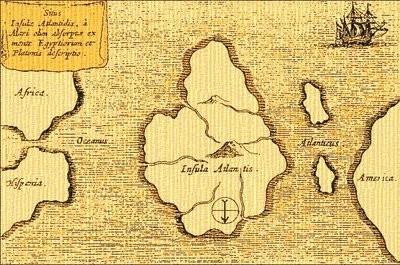
Plato described Atlantis as a city named after the continent it was on, to the west of the Pillars of Hercules. At the center of the continent was the most beautiful and fertile plain on Earth, and in the middle of the plain was a small hill. There were two rings of land and three of sea surrounding this hill, and a shrine to Poseidon and Cleito was placed on the hill, guarded by a golden wall that none could enter.
The temple was in a sacred grove and was 220 yd. (201 m.) long and 100 yd. (91 m.) wide. The exterior was covered in silver, except for figures on the pediment, which were covered with gold. Around the temple were statues of the first ten kings and their wives, as well as many others sponsored by rich citizens. Inside the hill was a statue of Poseidon driving six winged horses.
The continent was first populated by five sets of twins fathered by Poseidon. They were each given a tenth of the island, and the eldest, Atlas, had the continent and surrounding ocean named after him.
Two springs, one hot and one cold, provided an unlimited supply of water, which was famous for its quality. The springs were surrounded by suitable buildings and plantations, Separate baths were created for royalty, commoners, women, horses, and beasts of burden. The outflow led into the sacred grove, which was full of beautiful, tall trees. Aqueducts channelled the water to the rest of the city. Many temples were built on the other rings, as well as gardens and gymnasiums. The dockyards, especially the three outer harbors, were perpetually filled with triremes and equipment for the ships and kept in excellent condition.
A wall, beginning at the sea, was built beyond the outer harbors and 6 mi. (10 km.) away from the outermost wall. It was surrounded by houses and the harbor was crowded with armadas of merchant ships, from all over the world, creating a constant din of shouting and noise.